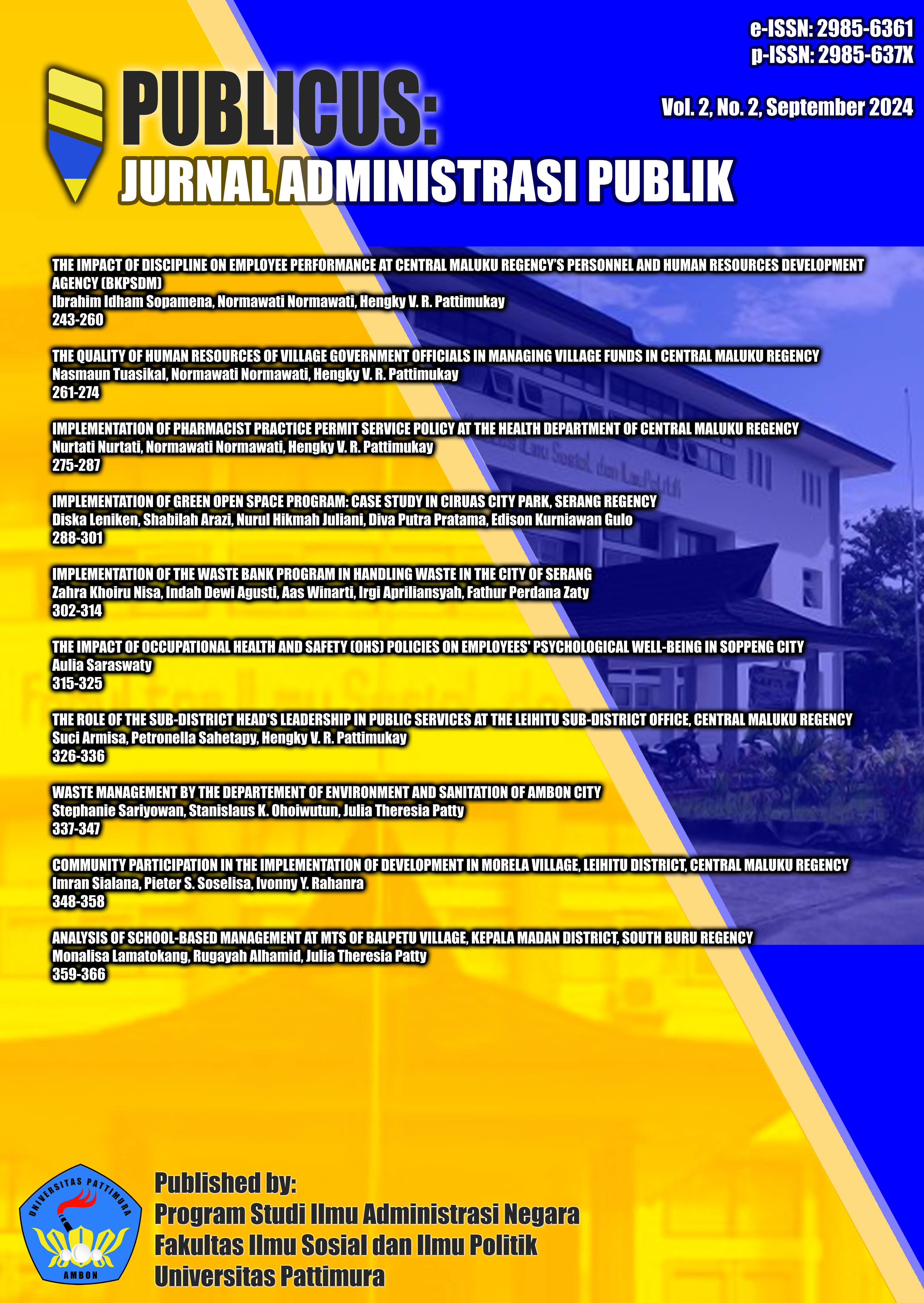IMPLEMENTATION OF GREEN OPEN SPACE PROGRAM: CASE STUDY IN CIRUAS CITY PARK, SERANG REGENCY
Abstract
One important component of a city is green open space, which serves to balance the ecological conditions of an area so that the development of modern development can be balanced with the ecosystem. The Ciruas City Park Green Open Space Program in Serang Regency is needed because several sub-districts in Serang Regency are industrial areas, which cause a lot of air pollution and the need for greening. This research method uses a qualitative approach and a literature review approach. In this study, the theory used, the policy implementation model proposed by G. Shabbir Cheema and Dennis A. Rondinelli, includes four factors: environmental conditions, inter-organizational relationships, resources, and the characteristics and abilities of implementing agents. The objectives to be achieved in this study are: (i) To find out how the implementation of the Ciruas City Park Green Open Space Program in Serang Regency is carried out, and (ii) What factors influence the implementation of the Ciruas City Park Green Open Space Planning Program in Serang Regency. Based on the studies that have been conducted, the research concludes that the Ciruas City Park Green Open Space Program in Serang Regency has not been maximized. This is due to many influencing factors such as the bad habits of the community and the lack of government attention to facilities.
Downloads
References
Annisa, N., Prasetia, H., & Riduan, R. (2020). Identifikasi Luas Area Ruang Terbuka Hijau (RTH) Kota Banjarbaru Berbasis Sistem Informasi Geografis. Jurnal Sumberdaya Alam Dan Lingkungan , 7, 91.
Ansori, Y. Z. (2019). Islam dan Pendidikan Multikultural. Jurnal Cakrawala Pendas, 5, 112.
Dwihatmojo, R. (2016). Ruang Terbuka Hijau yang Semakin Terpinggirkan. Badan Informasi Geospasial, 2.
Hartati, E., Nurdin, N., & Rivai, F. H. (2024). Implementasi Kebijakan Pembangunan Industri Rumahan Pemberdayaan Perempuan di Kabupaten Kulon Progo. Journal of Public Policy and Applied Administration, 6, 38.
Lestari, D. A., Larassaty, A. L., Widyani, R. A., Ikhsyan, M. J., & Setyorini, R. A. (2023). Pemanfaatan Lahan Kosong dan Sampah Plastik sebagai Ruang Terbuka Hijau di Desa Lebo. Nusantara Community Empowerment Review, 1, 96.
Magdalena, I., Salsabila, A., Krianasari, D. A., & Apsarini, S. F. (2021). Implementasi Model Pembelajaran Daring Pada Masa Pandemi Covid-19 di Kelas III SDN Sindangsari III. Jurnal Pendidikan Dan Dakwah, 3, 120.
Moleong, L. J. (2014). Metodologi Penelitian Kualitatif. PT. Remaja Rosdakarya.
Purnama, I. N. (2023). Implementasi Kebijakan Pengelolaan Ruang Terbuka Hijau (RTH) di Kota Serang. Jurnal Sosial Dan Humaniora, 1, 4.
Purnamaselfi, M. W., & Widyasamratri, H. (2021). Studi Literatur : Analisis Penyediaan Ruang Terbuka Hijau di Wilayah Urban. Jurnal Kajian Ruang, 1, 30.
Subarsono. (2015). Analisis Pembelajaran Konsep, Teori dan Aplikasi . Pustaka Pelajar.
Syukri, M. R. (2019). Penataan Ruang Terbuka Hijau Kawasan Permukiman di Kelurahan Tenilo. RADIAL – Jurnal Peradaban Sains, Rekayasa Dan Teknologi, 1, 66.
Copyright (c) 2024 Diska Leniken, Shabilah Arazi, Nurul Hikmah Juliani, Diva Putra Pratama, Edison Kurniawan Gulo

This work is licensed under a Creative Commons Attribution 4.0 International License.









